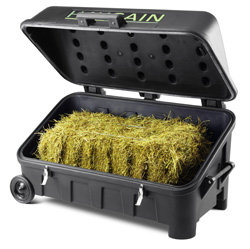Hay choice and feeding methods are especially important for horses with certain health problems.Hay choice and feeding methods are especially important for horses with certain health problems.

Heaves: Heaves, also called recurrent airway obstruction or chronic obstructive pulmonary disease, is similar to human asthma. Hay dust and mold aggravate it.
- Buy only hay harvested under the best conditions, and keep it inside and dry to avoid mold formation. Vegetative and early bloom hays generally have less dust than late bloom, mature hay.
- Feed hay on the ground or in a low bunk that allows the horse to eat with his head and neck in a naturally low position. This helps to keep any dust from the hay low to the ground and out of his airways.
- Wet the hay before feeding to reduce dust. You don’t need to soak for long-a dunk in water or spray with a hose should be enough.
- Alternatively, steam the hay. New electric hay steamers can efficiently steam up to a bale at a time. (The old-fashioned way is to put a few flakes in a clean metal trashcan, pour some boiling water over them, pop on the lid, and let stand for 30 minutes or so.) Steaming kills mold spores and bacteria. While it’s not clear how much this helps the horse, some people swear by it. Feed steamed hay promptly, as it will spoil sitting in the barn.
- Remove all uneaten hay from the stall daily, so mold won’t develop.
- House the horse as far from indoor hay storage as possible.
Equine metabolic syndrome: Horses with EMS suffer from insulin resistance, which is similar to type II diabetes in humans and is associated with an increased risk of laminitis and other problems. These horses are often obese, and diet is an important part of managing their problems. Where hay is concerned
- choose mid-bloom or mature grass hay, which tends to be lower in calories and sugars.
- have your hay tested for nonstructural carbohydrates-sugars, starches and fructans-and get a nutritionist or horse extension agent to help interpret the results. This type of testing is fairly new. NSC levels of less than 10 percent in the total diet (forage and concentrate) are thought to be safe for these horses, but research has yet to confirm that.
- soak hay for 30 minutes in warm water or 60 minutes in cold water to leach out some of the NSC content. There’s no evidence that steaming reduces NSCs. keep meals small-amounts consumed per meal also play a role.
Hyperkalemic periodic paralysis (HYPP): This inherited muscle disorder affects certain Quarter Horses and related breeds. Management steps include limiting potassium to less than 1 percent of the total diet-tricky, because most horse feeds and forages easily exceed that amount.
- Pair low-potassium grain with low-potassium hay. Oat hay is lowest, followed by peanut and Bermuda grass hay.
To read more about hay, see “All About Hay” in the November 2010 issue of Practical Horseman magazine.










